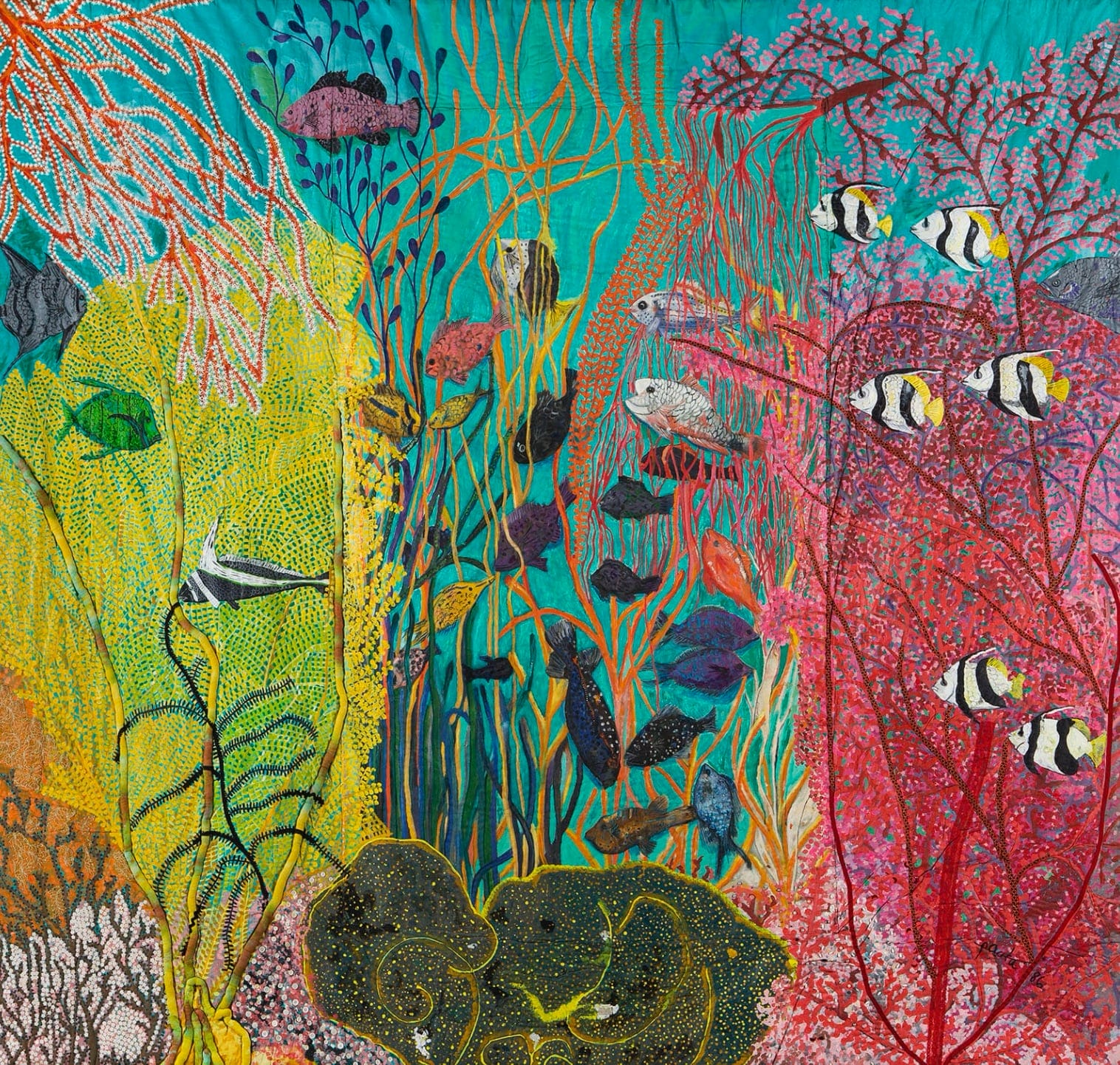This post was originally published on Colossal
“Shallow Gardens of Apo Reef” (1986), oil, acrylic, mirrors, plastic buttons, cotton yarn, rhinestones on stitched and padded canvas, 132 x 137 1/2 inches. All images courtesy of Pacita Abad Estate and Tina Kim Gallery, shared with permission
After a traumatic childhood moment in which she nearly drowned, Pacita Abad (1946-2004) developed a profound fear of water. The massively prolific Filipina-American artist decided to overcome her trepidation in the 1980s and signed up for diving lessons at the British Sub-Aquatic Club in Thailand. There, she learned to safely plunge into the depths of the sea, completing more than 80 dives across the Phillippines in her lifetime.
On view at Tina Kim Gallery in New York is a vivid series of trapunto paintings—a quilting technique that involves adding stuffing for puffed layers—inspired by Abad’s love for swimming. Titled Underwater Wilderness, the exhibition presents eight large-scale works made between 1985 and 1989. Plastic buttons, rhinestones, glitter, and sequins add textured dimension to the dense prismatic seascapes of tropical fish and plants. Evidence of Abad’s fascination with the lush ecosystems, the mixed-media works stitch together a vibrant tapestry of what lies below the surface.
As noted in the gallery’s statement about the exhibition, these paintings are widely regarded as the artist’s least political body of work, although their role in her practice is more nuanced. The text explains:
The series can perhaps be read as Pacita’s bridging of personal and political histories and the “manifold lived realities” of the Philippines. After she led student demonstrations against dictator Ferdinand Marcos in the late ’60s, her parents encouraged her to complete her studies abroad after her family home was sprayed with bullets. She was only able to return to live in the Philippines in 1982 after twelve years away and started this body of work the year before the fall of the kleptocratic regime in 1986.
This is the first time the works have been exhibited together since 1987. Underwater Wilderness is up through August 16.

“Dumaguete’s Underwater Garden” (1987), oil, acrylic, glitter, gold thread, buttons, lace, sequins on stitched and padded canvas, 85 1/4 x 118 inches

Detail of “Dumaguete’s Underwater Garden” (1987), oil, acrylic, glitter, gold thread, buttons, lace, sequins on stitched and padded canvas, 85 1/4 x 118 inches

“Sepoc Wall” (1985), oil, acrylic, mirrors and buttons on stitched and padded canvas, 139 1/2 x 132 inches

“The Far Side of Apo Island” (1989), oil, acrylic, gold thread, plastic buttons, lace, sequins on stitched and padded canvas, 88 1/4 x 69 inches

“Hundred Islands” (1989), oil, acrylic, glitter, gold thread, buttons, lace, sequins on stitched and padded canvas, 79 x 118 inches

Detail of “Hundred Islands” (1989), oil, acrylic, glitter, gold thread, buttons, lace, sequins on stitched and padded canvas, 79 x 118 inches

“Anilao at its Best” (1986), oil, acrylic, mirrors, plastic buttons, and rhinestones on stitched and padded canvas, 115 3/4 x 124 7/8 inches

Detail of “Anilao at its Best” (1986), oil, acrylic, mirrors, plastic buttons, and rhinestones on stitched and padded canvas, 115 3/4 x 124 7/8 inches

The artist
Do stories and artists like this matter to you? Become a Colossal Member today and support independent arts publishing for as little as $5 per month. The article Through Mixed-Media Quilts, Pacita Abad Dives Into the Lush Marine Ecosystems of the Philippines appeared first on Colossal.





0 Comments